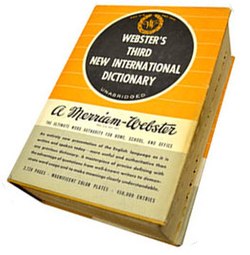 | |
| Language | English |
|---|---|
| Genre | Dictionary |
| Published | 1961 |
| Preceded by | Webster's New International Dictionary (second edition, 1934) |
Webster's Third New International Dictionary of the English Language, Unabridged (commonly known as Webster's Third, or W3) is an American English-language dictionary published in September 1961. It was edited by Philip Babcock Gove and a team of lexicographers who spent 757 editor-years and $3.5 million. The most recent printing has 2,816 pages, and as of 2005, it contained more than 476,000 vocabulary entries (including more than 100,000 new entries and as many new senses for entries carried over from previous editions), 500,000 definitions, 140,000 etymologies, 200,000 verbal illustrations, 350,000 example sentences, 3,000 pictorial illustrations and an 18,000-word Addenda section.
The final definition, Zyzzogeton, was written on October 17, 1960; the final etymology was recorded on October 26; and the final pronunciation was transcribed on November 9. The final copy went to the typesetters, R. R. Donnelley, on December 2. The book was printed by the Riverside Press in Cambridge, Massachusetts. The first edition had 2,726 pages (measuring 9 in or 230 mm wide by 13 in or 330 mm tall by 3 in or 76 mm thick), weighed 13+1⁄2 lb (6.1 kg), and originally sold for $47.50 ($484 in 2023 dollars[1]). The changes were the most radical in the history of the Unabridged.
The dictionary was met with considerable criticism for its descriptive (rather than prescriptive) approach to language.[2][3]
- ^ 1634–1699: McCusker, J. J. (1997). How Much Is That in Real Money? A Historical Price Index for Use as a Deflator of Money Values in the Economy of the United States: Addenda et Corrigenda (PDF). American Antiquarian Society. 1700–1799: McCusker, J. J. (1992). How Much Is That in Real Money? A Historical Price Index for Use as a Deflator of Money Values in the Economy of the United States (PDF). American Antiquarian Society. 1800–present: Federal Reserve Bank of Minneapolis. "Consumer Price Index (estimate) 1800–". Retrieved February 29, 2024.
- ^ Skinner, David (July–August 2009). "Ain't That the Truth: Webster's Third: The Most Controversial Dictionary in the English Language". Humanities magazine. 30 (4). National Endowment for the Humanities. Retrieved 2014-09-14.
- ^ Herbert Charles Morton. The Story of Webster's Third: Philip Gove's Controversial Dictionary and its Critics (1995). p. 123.
